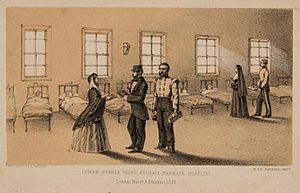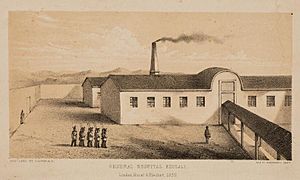Mary Francis Bridgeman facts for kids
Mother Mary Francis Bridgeman (1813 – 11 February 1888) was a nun with the Sisters of Mercy. This group of Catholic women was started in Ireland by Catherine McAuley. Mary Francis Bridgeman was also a very important nurse during the Crimean War from 1854 to 1856.
Contents
Early Life and Religious Calling
Mary Francis Bridgeman was born as Joanna Bridgeman in Ruan, County Clare, Ireland, in 1813. Her aunt, Mary Francis Xavier Warde, was one of the first Sisters of Mercy. When Joanna was five, her mother passed away. She then went to live with her aunt's family.
In 1832, a serious illness called cholera spread through Limerick. Joanna Bridgeman helped her aunt care for the sick. This experience showed her how much she wanted to help others.
In 1838, Joanna joined the Sisters of Mercy convent in Limerick. After a year of training, she became a nun in 1839 and took the name Sister Mary Francis. She was a strong leader and good at organizing things. By 1844, she became the Mother Superior, or head, of the convent.
Helping the Community
In 1844, Sister Mary Francis and a few other nuns went to Kinsale in County Cork. There, they started Saint Joseph’s convent. She worked hard to help sick and poor people. They opened a school and a soup kitchen, which provided food for those in need.
Later, the Sisters also started an orphanage for children without parents. They also ran an industrial school where 150 girls learned skills like lace-making and embroidery. This helped the girls earn a living. When cholera hit Kinsale in 1849, Bridgeman and her Sisters took over the local workhouse, caring for about 2,000 people.
Nursing During the Crimean War
The Crimean War (1854-1856) was a difficult time. Many soldiers died from diseases and poor care, not just from battle wounds. The British government needed experienced nurses quickly. They asked for help from Ireland, and the Sisters of Mercy immediately offered their services.
On December 2, 1854, Bridgeman and about 11 or 12 other Sisters left London. They traveled to Constantinople to help Florence Nightingale at Scutari Hospital. They were part of a second group of Irish nurses sent to the Crimea.
Challenges with Florence Nightingale
When they arrived in Constantinople on December 17, 1854, the Sisters received a surprising letter from Florence Nightingale. She said it was a "gross mistake" to send more nurses. Nightingale felt she had enough nurses and no space for more at Scutari. The War Office had forgotten to tell Nightingale that Bridgeman's group was coming.
Nightingale was upset because she felt her authority over nursing at Scutari was being challenged. Bridgeman, on the other hand, believed her group was independent and did not want to be under Nightingale's control. She felt her loyalty was to her own superiors in Ireland. Also, Nightingale was right that the doctors in the Crimea didn't need more nurses, and there was no room for them.
Five days later, Nightingale invited five of the Sisters to join her at Scutari, but not as nurses. Bridgeman understood this to mean they were free from their agreement with the War Office. So, in late January 1855, she arranged for her group to nurse at the Koulali General and Barrack hospitals, which were close to Scutari.
Helping Soldiers on the Frontline
When a cholera outbreak hit the army in the Crimea that month, Bridgeman and her Sisters immediately started working. They had experience with cholera from Ireland. The Sisters treated the sick and cared for the wounded and dying soldiers from the year-long Siege of Sebastopol. They spent their last six months helping at the General and Hut hospitals right on the frontline.
In October 1855, Dr. John Hall, a high-ranking hospital inspector, appointed Bridgeman as the Superintendent of the Balaclava General Hospital. This decision was made without telling Florence Nightingale, which made the tension between her and Bridgeman even worse. Despite the difficulties, various doctors and chaplains helped keep the peace, allowing the Sisters to continue their important nursing work. Nightingale sometimes called Bridgeman "Reverend Mother Brickbat."
There were also some disagreements between Bridgeman and Mary Clare Moore, who had arrived with the first group of Irish Sisters in October 1854. Bridgeman did not like or trust Nightingale. She made sure to get the support of Dr. John Hall, who also had issues with Nightingale.
As the war ended, Nightingale visited Bridgeman and her Sisters at the frontline hospitals. She invited them to join her at Scutari, but they chose not to go. The Sisters had introduced very effective ways of managing and nursing patients in the Crimea. Nightingale even asked for details about their methods. It is thought that some of the systems Bridgeman and her Sisters used might have been included in Nightingale's report to the War Office without giving them credit.
In April 1856, when Nightingale regained control of Balaclava General Hospital, Bridgeman immediately resigned. She said that she and her Sisters were no longer needed because fewer soldiers were sick or wounded, and peace was about to be declared. Peace was announced on April 2, 1856. Bridgeman and the Sisters left the Crimea on May 12, returning to England and then to their convents.
Later Years and Legacy
After returning from the Crimea, Bridgeman went back to her work in Kinsale. She stayed there until she passed away in 1888. The school she had started in 1844 had grown very large. By then, 1,000 children were getting a free education and hot meals in the winter.
Bridgeman also helped establish new convents in Ireland, including Clonakilty, Skibbereen, Newry, Doon, and Ballyshannon. She also helped set up convents in Derby, England, and in San Francisco and Cincinnati in the United States. She wrote a four-volume book about theology called God in His Works.
Mother Mary Francis Bridgeman died on February 11, 1888, at the convent in Kinsale, County Cork. She was buried in the cemetery of the Convent of Mercy in Kinsale. A memorial was placed in the church to remember her.
Images for kids






